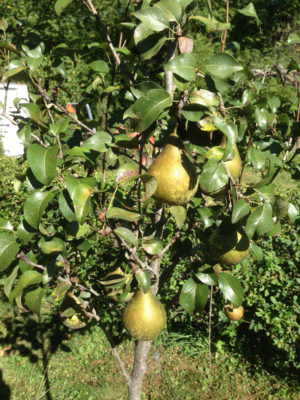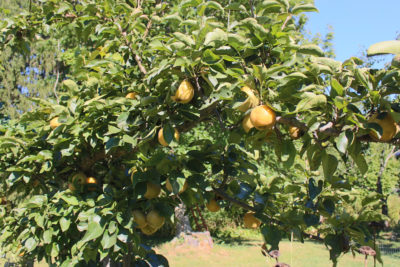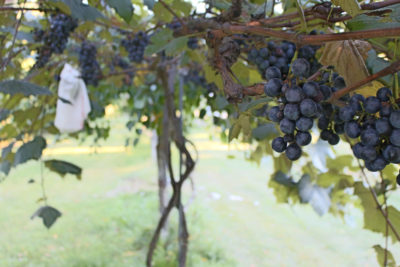FRUIT HARVEST, WHEN?
Easy to Grow, Hard to Harvest
Of all commonly grown tree fruits, pears are the easiest, mostly because they succumb to fewer pest and weather problems than do other common tree fruits. Of all commonly grown tree fruits, pears are the most difficult to harvest.
Timing is what makes pears so difficult to harvest, a skill I’m ashamed to admit I have yet to master. You can’t time when to pick by taste because pears are among the few fruits that will not ripen well on the tree. They start ripening from their innards outward so by the time the outside of the fruit looks and feels ripe, the innards are brown mush.

Concorde European pear, ripe?
No need to refer me to the guidelines of experts: The skin should undergo an almost imperceptible change in color, lightening or yellowing. The fruit softens ever so slightly, going from the firmness of a basketball to that of a softball. The fruit stalk separates readily from the stem when the fruit is lifted and given a slight twist. And finally, in my opinion the most obtuse indicator, lenticels (small pores on the skin) change from white and raised to brown and shallow. Yadda, yadda, yadda, . . .
I grow about 20 varieties of pear, and each of those very subtle indicators are slightly different for one variety to the next.
Another of my excuses is that most of my varieties are just beginning to bear so I don’t have a lot of fruits from each tree to play around with. I am adept at harvesting those varieties — Magness, Seckel, Harrow Delight — that have borne the most fruit for the most years.
Easy to Grow, Easy to Harvest
Ah, but my horticultural shortcomings don’t extend to all pears. I also grow a few varieties of Asian pears, which differ from the aforementioned and more common European pears in being usually round and of a few different species. Most significantly, Asian pears will ripen to perfection on the tree. In fact, for best flavor, they must remain hanging until dead ripe, at which point they have a “cracking” texture, that is, they are crisp but explode in your mouth with their sweet, ambrosial juice.

Yoinashi Asian pear
The skin of Chojuro, the earliest of my Asian pears, started changing from brown russet to golden yellow russet earlier this month. As a further check to ripeness, I picked a fruit and sunk my teeth into it. Delicious! They’re ripe and hang in good condition to be plucked from the branches, as needed, for a week or two, or they can be harvested in toto and refrigerated. The varieties Yoinashi and Seuri Li will follow shortly here, with Korean Giant following these two varieties next year, when it comes into bearing.
Asian pears are as easy, perhaps even easier, to grow than European pears. They bear at a young age and heavily, often too young and too heavily, which is why it’s necessary to grit your teeth and aggressively thin the fruits. Too heavy a crop stunts young trees or spells small, less flavorful fruits on grown trees. (I devote a whole chapter to Asian pears in my book Uncommon Fruits for Every Garden.)
And Then There are Grapes
Grapes . . . they’re easy to harvest ripe. Except that most people don’t. Color is but one indicator that a bunch wants to be harvested and eaten (that is, after all, fruits’ raison d’être). But like some other fruits — blueberries, for example — grapes turn their ripe color before they are dead ripe.

Concord grape
So I also pull off a berry or two to taste. The difference in flavor between just ripe and dead ripe is dramatic. And especially so with my bagged grapes, which can segue to the dramatic stage within their bags without threat of predation by birds and bees.
The variety Concord presents an exception to that last statement; birds don’t like the flavor and leave the berries alone. This means the berries don’t have puncture holes that attract bees and wasps, so they also are not a problem. The deterrent in Concord grapes is the chemical methyl anthranilate, which has been formulated as a spray to keep birds at bay. My wife also doesn’t like Concord.


Hey Lee, I wanted to tell you a funny story. I recently bought your book Grow Fruit Naturally and loved it! The week before I purchased your book I had checked a book out from the library about growing fruit trees in small spaces. My wife got confused and returned your book to the library, which, once the library noticed it wasn’t theirs, sold for $1. The librarian said it was on the for sale rack for a matter of hours. Worst part was I still got a late fine for not returning the other book on time. Oh well, I hope whoever bought it grows some good food! Love your blog and keep up the great work.
I will be renting for a few years. Should I get a pear and plum tree and put them in large pots until I settle down in 3 years? Or is that pointless?
I’ve done that, and would do it again. But realize that you’ll have to water the pots in summer and store them in winter somewhere cool but not frigid: unheated garage; or sunk up to their rims in holes in the ground; or clustered together with wood chips or other loose, organic material piled up around the pots. You’ll also need to do root pruning after a year or two, and stem pruning to keep the plants small.
Lee, I am growing 3 types of grapes that are 3 years in the ground now. I had fruits this year on two of them. Your notes about Concord- do they pertain to the Concord lineage? I am growing King of the North, Worden and another that I can’t recall– all concord type. I have netted them with the Tulle (proper spelling!!) and wonder if it is necessary. My daughter in south Jersey has tons of Bamboo with which I have constructed a trellis, and the tulle wraps beautifully around it. Interesting about the ripening: I picked a few bunches that were visibly ripe, but some were delectable and others were very tart! Now I understand.
I will be ordering some asian pears to replace my HOneycristp that bit the dust early this year: don’t know what Happened, but it always looked a bit “frail” compared to the others—also planted in 2013–and one day keeled over! I am in Jay, zone 4b.
Any thoughts? I usually order from St Lawrence or Fedco. Thank you in advance!
Not sure if what I wrote about Concord also applies to those other grapes. My guess is that ti does apply to any grape that tastes very similar to that distinctive taste of Concord.
Lee, not all Euro pears need to be picked hard, stored in the fridge for at least a couple weeks and then ripened indoors to avoid internal rot. These are ones easier to determine when to pick as the worst thing that can happen is you end up with a bunch of pears that are fine to eat but can’t be stored long. Because they don’t all ripen at once on the tree they even help you avoid this.
Two of the best for this are Seckel and Harrow Sweet. Harrow Sweet is, to my mind, the perfect pear for the home grower. It starts to bear in my nursery by the third year, has an exceptionally fine form (much like Seckel) in being unusually spreading for a pear, without the weeping craziness of Bartlett, bears more reliably than any pear I grow, besides maybe Harrow Delight, and seems to be resistant to fireblight, scab and pear psyla.
Best of all it gets up high sugar and is a great tasting pear that doesn’t tend to ripen until at least the first week of Oct. here in S. NY, when peaches are winding down (yes Oct. peaches are possible and delicious here, with the right varieties). That is when I personally begin craving the high sugar, low acid taste of pears.
Good points. I grow Harrow Delight and it has many of the same qualities you mention for Harrow Sweet, but ripening about a month earlier. Also Seckel, which I do pick ripe. Personally, I crave the less sweet fruits as the autumn fruit season progresses. Thanks for all the information.